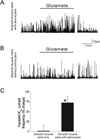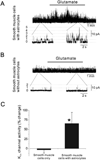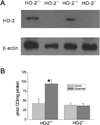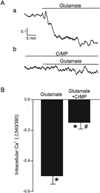Astrocyte-derived CO is a diffusible messenger that mediates glutamate-induced cerebral arteriolar dilation by activating smooth muscle Cell KCa channels
- PMID: 17991880
- PMCID: PMC3460645
- DOI: 10.1161/CIRCRESAHA.107.164145
Astrocyte-derived CO is a diffusible messenger that mediates glutamate-induced cerebral arteriolar dilation by activating smooth muscle Cell KCa channels
Abstract
Astrocyte signals can modulate arteriolar tone, contributing to regulation of cerebral blood flow, but specific intercellular communication mechanisms are unclear. Here we used isolated cerebral arteriole myocytes, astrocytes, and brain slices to investigate whether carbon monoxide (CO) generated by the enzyme heme oxygenase (HO) acts as an astrocyte-to-myocyte gasotransmitter in the brain. Glutamate stimulated CO production by astrocytes with intact HO-2, but not those genetically deficient in HO-2. Glutamate activated transient K(Ca) currents and single K(Ca) channels in myocytes that were in contact with astrocytes, but did not affect K(Ca) channel activity in myocytes that were alone. Pretreatment of astrocytes with chromium mesoporphyrin (CrMP), a HO inhibitor, or genetic ablation of HO-2 prevented glutamate-induced activation of myocyte transient K(Ca) currents and K(Ca) channels. Glutamate decreased arteriole myocyte intracellular Ca2+ concentration and dilated brain slice arterioles and this decrease and dilation were blocked by CrMP. Brain slice arteriole dilation to glutamate was also blocked by L-2-alpha aminoadipic acid, a selective astrocyte toxin, and paxilline, a K(Ca) channel blocker. These data indicate that an astrocytic signal, notably HO-2-derived CO, is used by glutamate to stimulate arteriole myocyte K(Ca) channels and dilate cerebral arterioles. Our study explains the astrocyte and HO dependence of glutamatergic functional hyperemia observed in the newborn cerebrovascular circulation in vivo.
Figures







Similar articles
-
Carbon monoxide and Ca2+-activated K+ channels in cerebral arteriolar responses to glutamate and hypoxia in newborn pigs.Am J Physiol Heart Circ Physiol. 2007 Nov;293(5):H3193-200. doi: 10.1152/ajpheart.00274.2007. Epub 2007 Aug 31. Am J Physiol Heart Circ Physiol. 2007. PMID: 17766483 Free PMC article.
-
Glutamate regulates Ca2+ signals in smooth muscle cells of newborn piglet brain slice arterioles through astrocyte- and heme oxygenase-dependent mechanisms.Am J Physiol Heart Circ Physiol. 2010 Feb;298(2):H562-9. doi: 10.1152/ajpheart.00823.2009. Epub 2009 Dec 4. Am J Physiol Heart Circ Physiol. 2010. PMID: 19966053 Free PMC article.
-
Functional role of astrocyte glutamate receptors and carbon monoxide in cerebral vasodilation response to glutamate.Am J Physiol Heart Circ Physiol. 2012 Jun 1;302(11):H2257-66. doi: 10.1152/ajpheart.01011.2011. Epub 2012 Mar 30. Am J Physiol Heart Circ Physiol. 2012. PMID: 22467311 Free PMC article.
-
Carbon monoxide as an endogenous vascular modulator.Am J Physiol Heart Circ Physiol. 2011 Jul;301(1):H1-H11. doi: 10.1152/ajpheart.00230.2011. Epub 2011 Apr 15. Am J Physiol Heart Circ Physiol. 2011. PMID: 21498777 Free PMC article. Review.
-
Carbon monoxide and hydrogen sulfide: gaseous messengers in cerebrovascular circulation.J Appl Physiol (1985). 2006 Mar;100(3):1065-76. doi: 10.1152/japplphysiol.00793.2005. J Appl Physiol (1985). 2006. PMID: 16467393 Free PMC article. Review.
Cited by
-
Regulation of haeme oxygenase-1 for treatment of neuroinflammation and brain disorders.Br J Pharmacol. 2008 Nov;155(5):623-40. doi: 10.1038/bjp.2008.342. Epub 2008 Sep 15. Br J Pharmacol. 2008. PMID: 18794892 Free PMC article. Review.
-
Custom astrocyte-mediated vasomotor responses to neuronal energy demand.Genome Biol. 2009 Feb 16;10(2):209. doi: 10.1186/gb-2009-10-2-209. Genome Biol. 2009. PMID: 19232077 Free PMC article. Review.
-
Glutamate-induced calcium signals stimulate CO production in piglet astrocytes.Am J Physiol Heart Circ Physiol. 2011 Aug;301(2):H428-33. doi: 10.1152/ajpheart.01277.2010. Epub 2011 May 13. Am J Physiol Heart Circ Physiol. 2011. PMID: 21572018 Free PMC article.
-
Smooth Muscle Ion Channels and Regulation of Vascular Tone in Resistance Arteries and Arterioles.Compr Physiol. 2017 Mar 16;7(2):485-581. doi: 10.1002/cphy.c160011. Compr Physiol. 2017. PMID: 28333380 Free PMC article. Review.
-
The Potential Role of Hydrogen Sulfide in the Regulation of Cerebrovascular Tone.Biomolecules. 2020 Dec 16;10(12):1685. doi: 10.3390/biom10121685. Biomolecules. 2020. PMID: 33339440 Free PMC article. Review.
References
-
- Harder DR, Alkayed NJ, Lange AR, Gebremedhin D, Roman RJ. Functional hyperemia in the brain: hypothesis for astrocyte-derived vasodilator metabolites. Stroke. 1998;29:229–234. - PubMed
-
- Iadecola C. Neurovascular regulation in the normal brain and in Alzheimer's disease. Nat Rev Neurosci. 2004;5:347–360. - PubMed
-
- Pascual O, Casper KB, Kubera C, Zhang J, Revilla-Sanchez R, Sul JY, Takano H, Moss SJ, McCarthy K, Haydon PG. Astrocytic purinergic signaling coordinates synaptic networks. Science. 2005;310:113–116. - PubMed
-
- Haydon PG. GLIA: listening and talking to the synapse. Nat Rev Neurosci. 2001;2:185–193. - PubMed
Publication types
MeSH terms
Substances
Grants and funding
LinkOut - more resources
Full Text Sources
Molecular Biology Databases
Miscellaneous

